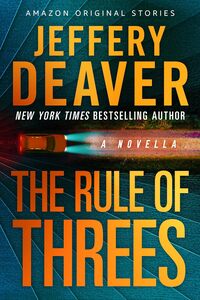Downstate by Jeffery Deaver
 Friday, January 3, 2025 at 8:12AM
Friday, January 3, 2025 at 8:12AM 
Published by Amazon Original Stories on January 14, 2025
Jeffery Deaver has written a few novellas for the Amazon Original Stories series. The story “Dodge” in his Broken Doll series introduced Special Agent Constant Marlowe. Constant’s own series of stories began with “The Rule of Threes” and continues in “Downstate.”
Constant is a boxer. That isn’t quite enough to sustain interest in her character over the course of a novel, a problem that Deaver accommodates by featuring her in shorter works where her absent personality might be less noticeable.
Constant works for the Illinois Department of Criminal Investigations. She starts the story by being shipped downstate to Plains County, a place that has more in common with the deep South than the progressive North. Her mission is to identify and find Mr. X, take him into custody, and persuade him to testify against Tyson Barth, a mobster in the Chicago suburbs.
Mr. X specializes in finding information. How he does this is a detail Deaver doesn't bother to explain. Barth hired Mr. X to identify two witnesses who have agreed to testify against him. Barth presumably intends to kill the snitches when he learns their identities. Since Mr. X takes as much pride in keeping his secrets as he does in learning the secrets of others, his true identity is a mystery. Although he feels no guilt about laying the groundwork for murder until he meets Constant, he feels embarrassed when she guides him on a path toward reform. I felt a bit embarrassed at my attempt to swallow any of this.
Constant enlists the help of Plains County Sheriff William Dodd and of Deputy Trenton Carr. Because someone in law enforcement has likely been leaking information to Barth, the reader will know that at least one of the cops is untrustworthy.
In an episode that appears to be unrelated to the central story (so, of course, it isn’t), a young man named Felipe Vargas steals some gift cards from a convenience store. A man in the store gives chase. Constant, who is visiting the store to buy milk and cookies (how wholesome can a woman get?), chases the man to keep him from beating the teen too badly. This encounter branches into a story about sex trafficking, the default option of thriller writers who want to shock readers but can’t come up with an original idea.
In another episode, two tough guys try to intimidate Constant. As other stories in the series have demonstrated, Constant likes to resolve such problems by securing her gun before challenging the tough guys to a boxing match. After knocking them to the ground, she arrests them or decides that a good beating was punishment enough for acting like a tough guy. Her behavior is more than a little ridiculous — I can’t imagine her not facing discipline for challenging perps to fistfights — but it seems to be her signature.
Constant devises a scheme to find Mr. X, which leads her to some dirty cops, which leads her to fear that a cop is endangering Vargas, which causes her to snatch Vargas as she devises a way to turn Mr. X against Barth and save Illinois from another of those dreaded sex trafficking rings. The plot fails to convey a sense of reality but I was almost willing to suspend my disbelief until the final scenes bestow an out-of-the-blue happy ending on one of the characters. Unable to overcome my gag reflex, I downgraded a tepid but full recommendation to a limited recommendation for diehard Deaver fans and readers who love happy endings, no matter how forced they might be.
RECOMMENDED WITH RESERVATIONS



